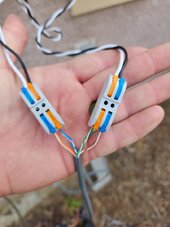I have a somewhat unusual situation in planning out my upgraded system: How to install the inverter's (and other monitoring devices') CT's right after the grid meter location. Problem is this: grid power comes in from the pole to the barn; there is the meter and then a small panel with 200A split phase breakers. There are a few (like 6 or so) barn CBs, and then this panel feeds some 4/0 Al UF line which runs ~150' to another 200A main breaker which is outside the main house and feeds a CB distribution panel in the house. The inverter, and various monitoring devices will be at the basement level of the house. The inverter and all the various monitoring devices would like their CT's placed between the meter and that first 200A breaker, to get an accurate measure of current going to/from the grid. That will likely need about a 160' or more (with obstacles and all) "extension" to do that.
I have read various reports of people doing this sort of thing, but typically over less distance (like <100') using Cat5 or Cat6 outdoor cable. However seems to me that the added resistance of 150' to 200' of 22ga copper wire would throw off the CT measurements. On some devices it may be possible to change the CT parameters to account for this, but not always.
I'd be interested in hearing from folks that have tried this, if/how well it worked for you, and what devices you tried it with. And if there are better ways of doing this, I'm all ears. What do folks think?
I have read various reports of people doing this sort of thing, but typically over less distance (like <100') using Cat5 or Cat6 outdoor cable. However seems to me that the added resistance of 150' to 200' of 22ga copper wire would throw off the CT measurements. On some devices it may be possible to change the CT parameters to account for this, but not always.
I'd be interested in hearing from folks that have tried this, if/how well it worked for you, and what devices you tried it with. And if there are better ways of doing this, I'm all ears. What do folks think?




